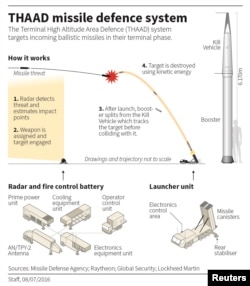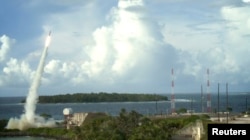The U.S. said Tuesday it has successfully shot down a simulated incoming missile, bolstering its defense against the threat posed by North Korea's recent test launch of an intercontinental ballistic missile that could reach the United States.
The U.S. Missile Defense Agency said in its test it launched a ballistic missile from a fighter jet over the Pacific Ocean north of the island state of Hawaii. But it said the military's Terminal High Altitude Area Defense (THAAD) system in the far northwestern state of Alaska "detected, tracked and intercepted the target."
The test was the first time the U.S. has deployed THAAD in an effort to shoot down an intermediate-range ballistic missile, a faster and more difficult target to hit than shorter-range missiles.
"The successful demonstration of THAAD against an [intermediate]-range missile threat bolsters the country's defensive capability against developing missile threats in North Korea and other countries around the globe and contributes to the broader strategic deterrence architecture," the agency said.
New urgency
The test took on new urgency with North Korea's successful launch of an ICBM last week that analysts believe has the range to hit Alaska, although not Hawaii and the 48 contiguous U.S. states. North Korea, despite sanctions imposed by the United Nations, has been developing nuclear weapons and launched numerous missile tests to advance the capabilities of its arsenal.
Lieutenant General Sam Greaves, director of the Missile Defense Agency, said in a statement, "I couldn't be more proud of the government and contractor team [led by Lockheed Martin] who executed this flight test today.
"This test further demonstrates the capabilities of the THAAD weapon system and its ability to intercept and destroy ballistic missile threats," he said. "THAAD continues to protect our citizens, deployed forces and allies from a real and growing threat."
THAAD incorporates "hit-to-kill" technology, where kinetic energy from the interceptor missile destroys the incoming target.
The Missile Defense Agency said Tuesday's successful intercept was its 14th in 14 attempts.
The U.S. also has a THAAD system installed in Guam and this year began deploying it in South Korea, as a defense against the possibility of a North Korean attack on the Korean Peninsula.
China has protested the U.S. installation of THAAD in South Korea, saying its powerful radar can probe deep into its territory and risked upsetting the strategic balance of power in the region.










